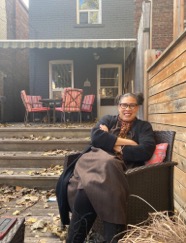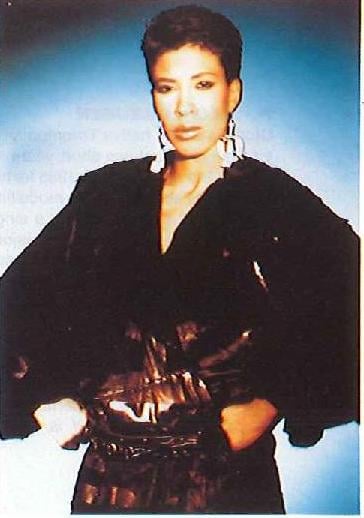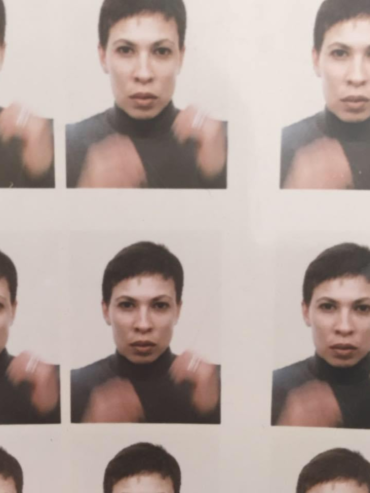June 2022
Month 20xx
Carolyn Bridgeman, Gabby Cleveland, & Julian Beltrano
Charmaine Gooden
Carol Martin
Grinning ear-to-ear, fashion icon Sharmain Beddoe-Howard sports a classic black calf-length knit cardigan layered over a soft mocha brown dress and styled alongside a puckered dyed scarf bursting in rich raspberry and plum colours, suede lace-up boots, tights and a pair of pigtails to match.
It’s been more than 40 years since Beddoe-Howard entered the fashion industry, and it’s clear she hasn’t lost her touch.


Early Life and Career
On October 26, 1960, Sharmain Beddoe-Howard was born in Boissiere Village, just east of Port of Spain in Trinidad and Tobago, where she lived with her parents and three siblings Ann Marie, Katina and Adam. Five years later, with her walking-doll in hand, Beddoe-Howard, alongside her grandmother, arrived in Canada, where she was reunited with her parents, who had moved to Toronto in 1963.
At the ripe age of 16, Beddoe-Howard was headhunted on the streets of New York and recruited by a modelling agency. This would mark the beginning of Beddoe-Howard’s modelling career. After quickly dominating the North American fashion arena, Beddoe-Howard set off to tackle new territory in Europe, where she worked with some of fashion’s most extraordinary designers, from Yves Saint Laurent to Vivienne Westwood.
Beddoe-Howard says “One of my favourite people to work with was Yves Saint Laurent; He was a genius who never took measurements. You would have to put a leotard on, and he would sort of line you all up, look at you, and put the measurements together by visualizing them on his model.”
I would be told my legs are too long, that I’m not black enough or that I’m not light enough.
Breaking Barriers
However, modelling wasn’t always as glamorous as it appeared to be, according to Beddoe-Howard. During the pre-digital age, before the 1980s, Black models and models of colour were blocked by systemic racism within the industry. “I would be told my legs are too long, that I’m not Black enough or that I’m not light enough,” says Beddoe-Howard.
While Black models were approved for the runway, appearing on magazine covers was still considered controversial, according to Beddoe-Howard. “To become a really good Black artist, you had to build this facade. But why does an artist have to come from the street?” muses Beddoe-Howard.
And while the fashion industry has seen some improvements in terms of greater diversity and representation, persistent problems of systemic racism remain an ongoing issue within it. For example, Naomi Campbell has been on the cover of American Vogue 8 times while, in comparison, Gigi Hadid has covered appeared on 35 international Vogue covers.
The Cameron House
Following her time spent abroad, Beddoe-Howard returned to Toronto in her early 20s. While juggling fashion shows, she began waitressing at the Queen Street West treasure and funky neighbourhood hotspot, The Cameron House. Eventually, Beddoe-Howard bought into the music venue and became an operating owner alongside friend Cindy Matthews.
In Beddoe-Howard’s opinion, The Cameron House was unlike any other bar in Toronto. The venue walls were constantly being dressed in new art. During the day, World War II vets filled the bar seats, and in the evenings, chatter and live music filled the air while an entirely new crowd consumed the dance floors. “We were the one club that had gay nights, Black nights and constantly changing art.”
It wasn’t until the 1980s that Black creatives received the acknowledgment they deserved, said Beddoe-Howard. It was a time of significant expansion, “suddenly people of color were appearing in magazines other than Ebony magazine.”
It wasn’t until the 1980s … suddenly people of colour were appearing in magazines other than Ebony magazine.
Influence and Legacy
In 1998, Beddoe-Howard met her husband, Daniel Howard. “It was love at first sight,” says Beddoe-Howard. And 22 years later, we’re still in love. You know I’m lucky.”
Beddoe-Howard went on to work in PR with the jewellery company Erickson Beamon (now Vicki Sarge). She has a deep appreciation for jewelry, particularly Tuareg jewelry created by the Tuareg, a nomadic tribe from North Africa. “You could wear a paper bag, but if you have beautiful jewellry on, you can be fabulous and ready to go.” And though Beddoe-Howard describes her position at Erickson Beamon as especially exciting, she eventually left after seven years to spend more time with her son, Luke.
Currently, Beddoe-Howard resides in Peckham, a district in southeast London, England, which Daniel, Luke her and two border terriers Lola and Jet. She is completing a Master’s while simultaneously working at an outreach program.
Even though Beddoe-Howard says her modelling days are behind her, her fabulous style says otherwise. While in tune with current fashion trends, her outfit echoes her beaming personality, warmth and individuality. “That’s what I love about fashion, having your own sense of style. I love the fact that I’ve finally gotten to a point where I like my sense of style. It doesn’t matter whether anybody else likes it. It doesn’t matter if it is considered a trend. It’s me, I like it, I feel good about it, and it gives me confidence.”
“There are people that years ago would never be considered to be beautiful that are now on the forefront of beauty.
“It’s your generation that’s melting the walls of all the cultural taboos, where people are recognizing the relevance of culture.”
Beddoe-Howard appreciates embracing our differences and branching out when it comes to fashion. “However,” she says, “There is one thing I know, until the day I die, I will not be running around in trainers and a tracksuit.”
Aside from fashion’s promotion of self-expression, Beddoe-Howard appreciates its changing nature. She recognizes that fashion is taking strides towards greater inclusivity, and through models such as Alex Wek, the industry is finally starting to see the representation it needs.
“There are people that years ago would never be considered to be beautiful that are now on the forefront of beauty,” says Beddoe-Howard. “And it’s your generation that’s melting the walls of all the cultural taboos, where people are recognizing the relevance of culture.”
References and related links:
- https://www.instagram.com/sharmainbeddoe/
- https://nowtoronto.com/music/features/cameron-house-90s-soul
- https://go-gale-com.ezproxy.lib.ryerson.ca/ps/i.do?p=CPI&u=rpu_main&id=GALE%7CA163596456&v=2.1&it=r&sid=summon
- Co-owner Sharmain Beddoe-Howard of the Cameron House
- https://trakt.tv/people/sharmain-beddoe?sort=released,asc
- https://www.pressreader.com/canada/now-magazine/19920507/281517929624172
- https://www.businessoffashion.com/articles/news-analysis/fashions-long-road-to-inclusivity
- https://www.vogue.com/article/naomi-campbell-behind-the-scenes-cover-youtube
- https://ca.style.yahoo.com/gigi-hadid-way-vogue-covers-ever-210729614.html
- https://www.bradshawfoundation.com/tuareg/
- https://www.wmagazine.com/story/jewelry-insider-vicki-sarge
- https://www.insider.com/peckham-london-coolest-neighborhood-photos-what-its-really-like-2019-9
- https://www.facebook.com/sharmain.beddoehoward
About the authors:
No posts found!
No posts found!
No posts found!





